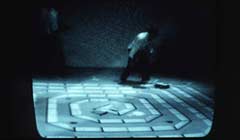STROLL ON
|
 |
| close |
The ‘1979’ exhibition was curated to coincide with the 2005 British Art Show – 1979 being the year of the first British Art Show, when I created the work ‘Stroll On’ for the Hayward Annual, Hayward Gallery, London.
I agreed to remake this installation and performance for the following reasons:
- I was interested to see if a systems-based Minimalist performance work could still have currency in today`s climate.
- The original installation was part of an on-going series of site-specific pieces which utilised architectural features to underpin visual structures. How might I achieve this in an entirely different space?
- I had kept meticulous instruction notes and felt that, similar to a playwright, it would be perfectly possible to re-make the piece and was curious to see how this process might unfold. • The philosophy of the American Bloomberg finance company seemed a million miles away from the philosophy held by most artists in 1979. I was keen, therefore, to see how today`s fast and extremely commercially-driven art world would deal with a slow, soft and, in entertainment terms, ‘difficult’ piece.
I still had my initial sketches and notes, musical score, photographs, diagrams, audio and video tapes from the original performances and began re-working these so that, although the new ‘Stroll On’ looked and sounded virtually the same as the first incarnation, it was visually slightly sharper and audibly crisper. The rhythms, cycles and spiral patterns contained within it have elements which allude to the meteorological weather cycles and cyclone models that have been part of my recent research. A performance involving people participating in a hypnotic, ritualistic cyclical process seemed, therefore, an interesting experiment to carry out as a visual metaphor connected to this research.
The four bullet-point problems set out above were addressed as follows:
- Many students that I teach have, over recent years, expressed a great interest in the period of the 60s and 70s in relation to ideas set within today`s art scene. I therefore invited four students (from Fine Art Sculpture and Digital Music at the University of Brighton) to take part in the performance to give them first-hand experience of the activity and enable them to meet some of the artists whose work they were aware of in the group show. This team worked with me to develop the piece with my role being that of ‘director’. I was very encouraged by their enthusiastic response to the first rehearsal and the ways in which they were able to relate its format to contemporary music`s analogue and digital concepts and processes. I had introduced the rehearsals with a short history of the work, putting it into context using original diagrams and audio tapes. Large prints of these images were hung in the Bloomberg gallery to give similar contextual information to the viewing public.
- Part of the constructional detailing of the original piece is that it is based on a grid-system following the 12”x12” tiling pattern of the Hayward Gallery floor. The Bloomberg floor also has tiles. However, these are 500mmx500mm and are black rather than grey. The Bloomberg SPACE forms the floor of a large glazed atrium, with a balcony surrounding it. This therefore provides excellent overhead viewing positions and the acoustics encourage the sound to spiral upward. The size and colour of the tiles, however, meant that I had to alter various measurements and divisions within the floor drawing, causing changes within the visual and audible rhythms. These changes to the musical and choreographic ‘score’ allowed me to rethink the overall performance structure, keeping it fresh. (The tile measurements were not the only problem concerning the expensive stone flooring: A meeting involving two curators, one gallery administrator, one senior Health&Safety Officer plus his assistant was needed to test whether the glue from the PVC electrical tape used to set out the floor markings would prove harmful to it – an issue not of great concern in 1979..)
- The instruction notes, documentation and audio tapes allowed the new performers to analyse various aspect of the original work. The old musical manuscript allowed me to easily transpose rhythms and harmonic structures to follow the altered floor pattern and acoustics. In addition to this, I had asked for a video of the performance to be playing during the exhibition when nothing was happening ‘live’ I also used the original video to assist me in checking a variety of performance cues.
- Although, as a more experienced artist, the new ‘Stroll On’ was structurally cleaner and tighter, it retained its relentless, hypnotic and very pure format. I had imagined that the audience would become restless and lose focus on the work. This did not happen, however, and it was extremely well received.
“Charlie Hooker`s seminal sonic installation Stroll On”
The Guardian Guide
“The jewel of ‘1979’ was Charlie Hooker`s re-staged Stroll On”
Frieze Magazine
“...he would make a provocative Artist in Residence at the National Gallery...”
The Spectator
“As we used to say in the Seventies: stroll on”
The Times
website:Wil Baldwin